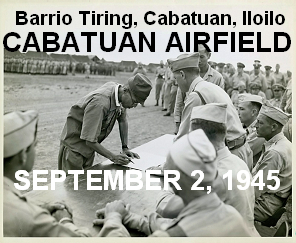
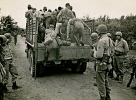

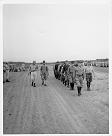


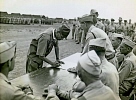
Col. Ryoichi Tozuka signs the surrender instrument
as Col. Raymond G. Stanton looks on.
Cabatuan Airfield
Barrio Tiring, Cabatuan, Iloilo
Panay Island, Philippines, September 2, 1945
|
|
- o -
|
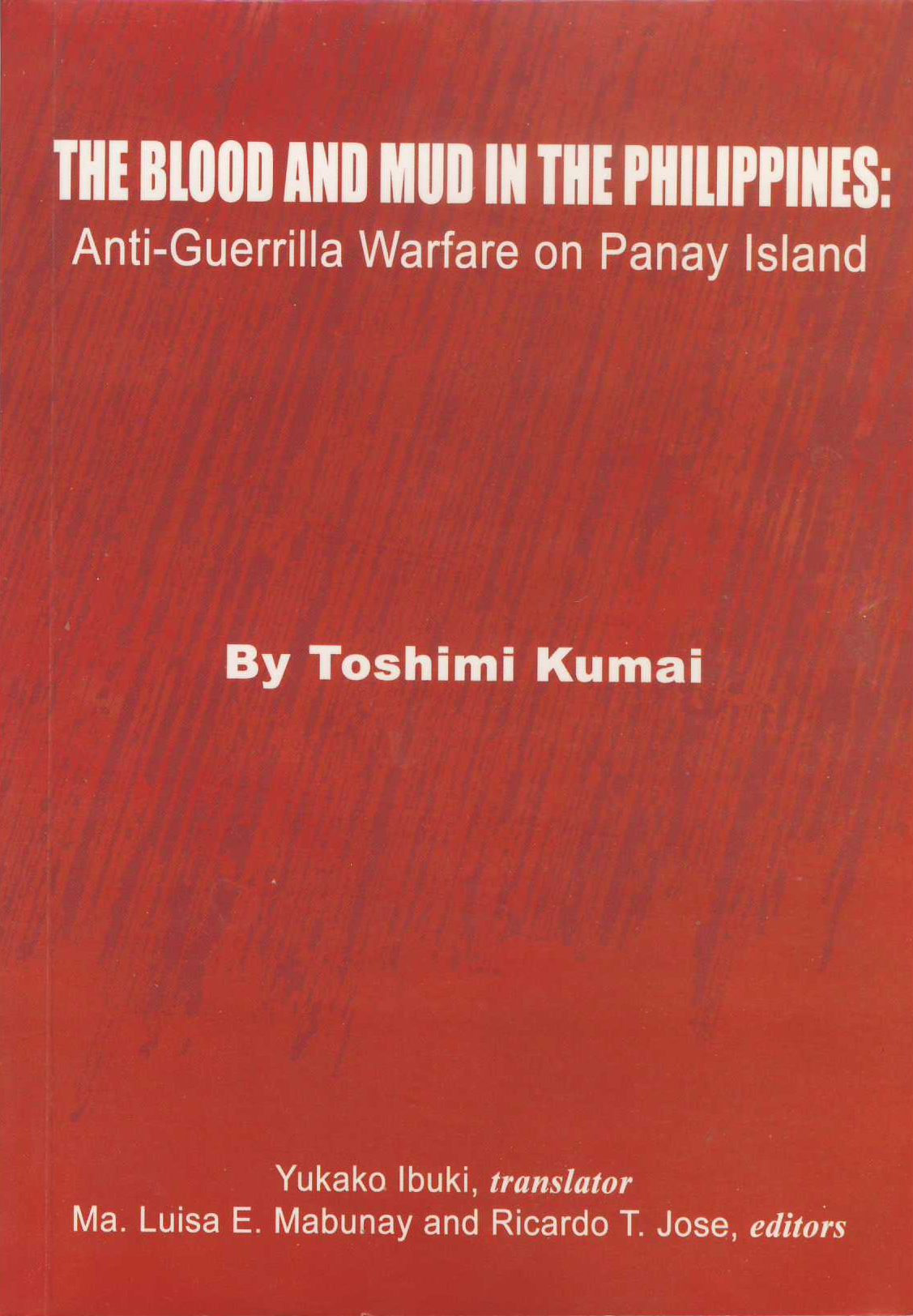
The Blood and Mud in the Philippines
Anti-Guerrilla Warfare on Panay Island
by Toshimi Kumai
Yukako Ibuki, translator
Ma. Luisa E. Mabunay and Ricardo T. Jose, editors
|
|
11.3 War Crimes Tribunal
The venue for the War Crimes Tribunal used to be the official residence of the US High Commissioner before the war. During the Japanese occupation, it was the official residence of Lieutenant General Homma. Currently, it is the American Embassy. The complex, which had been damaged and burned from the street fighting and fires that ravaged across the city of Manila, was given emergency repairs by the US forces for the use of the tribunal. There were three buildings of cells for the suspects, with a narrow 30 square-meter walking space. There were courtrooms and investigation rooms as well, although barbed wires and canvas surrounded the 150-square meter area. We could hear the wave sounds of Manila Bay and could see Bataan Peninsula and Corregidor beyond the sea. Nevertheless, the heat inside the cells was deadly.
On the next day, June 3, the full-scale investigation by prosecutors started. It went on day after day, exhausting everyone who was anxious to know how they may be saved from the death penalty at the end of each day.
In these circumstances, we heard of how the executions of Captain Makoto Yoshioka of the 4th company and 2nd Lieutenant Okuda, a platoon commander, were carried out. They had been tried separately from us for the execution of American pilots. We were told that they both were calm all the way and when they left for the execution ground, they saluted the others in a moment of stillness.
In the few secret meetings of the Panay suspects, we discussed and agreed that we would never mention any names of our comrades. We would be calling witnesses from among ourselves and not anyone who had already returned to Japan. However, what infuriated us was the fact that the prosecutors decided not to prosecute staff officer Colonel Hidemi Watanabe, the main person responsible for the Panay cases. We were the ones being investigated as suspects, beaten down with the fear of death. Why? Colonel Watanabe had been the actual commander of the punitive expeditions in Panay. In teaming up with Captain Kengo Watanabe, he forced everyone to pursue the brutal punitive battles. He had ordered Captain Watanabe to produce more and more brilliant war results, unmindful of how they were obtained.
We were all outraged with the decision made by the Military Commission but we could do nothing about it. The blame for the crimes of this VIP, who the Americans decided not to indict, was going to fall upon us. It made matters more and more disadvantageous for us.
The first trial towards the end of June was for Colonel Tozuka. Just as in the case of the trial of General Kôno, the prosecutor presented 30 to 40 witnesses one after another who vividly described a number of cases. Colonel Tozuka brushed aside these testimonies, saying, ‘I do not know anything about that.’ His lawyer was astonished and strictly criticized him, ‘Do you think all these cases can be done away with ‘I do not know’? Why are you not thinking of the trials of your subordinates that will follow yours? Have you no compassion for them?’ Among the witnesses, former Iloilo Provincial Governor Fermin Caram appeared at the court. He gave a simple testimony about unit commander Tozuka, ‘He was a cruel commander.’ By the end of June, before his lawyer could provide any decent defense, Colonel Tozuka was sentenced with the death penalty.
The second trial was a joint one of 2nd Lieutenant Noriyuki Ôtsuka and Master Sergeant Kuwano. The incidents included the killing of ten American civilians in the mountains of Tapaz, and others across the whole route of the punitive operations. Apparently prepared for the worst, Second Lieutenant Ôtsuka attended the trial with a fair and decent attitude and concentrated on saving the life of his subordinate Master Sergeant Kuwano.
His good-spirited attitude as a soldier impressed his lawyer and the presiding judge. The prosecutor presented witnesses from among local residents one after another. Every time they mentioned Kuwano, Second Lieutenant Noriyuki Ôtsuka took the blame on himself, saying ‘I am to I blame for all that.’ The most powerful of the prosecutor’s witnesses was a former spy for the Japanese Army named Jesus (Astrologo), who could well be called a former disciple of Ôtsuka. A Philippine trial was waiting ahead for him as a collaborator of the Japanese since collaboration was considered treason in the Philippines. Ôtsuka was considerate that the punishment for Jesus would be as light as possible, and always faced Jesus with smiles. Ôtsuka did not contradict any of Jesus’ testimony and instead seemed to encourage him. Jesus was moved by this attitude. Aware of Ôtsuka’s intention, he did not give any testimony that was disadvantageous for Master Sergeant Kuwano. Jesus was shedding tears when he left the courtroom. In the end, the sentence was death by hanging for Ôtsuka while Master Sergeant Kuwano miraculously received a life sentence due to his joint trial with Lieutenant Ôtsuka.
July 4, 1946 was the day of independence of the Philippines. From outside the camp saluting salvos sounded from US warships harbored in Manila Bay. In the-air was the droning of Superfortresses (B-29s) in a great formation. On the street fronting the Bay View Hotel and the court, was a grand brass band parade. The exciting scenes of national celebration unrolled all day in front of our eyes.
The next day, July 5, was the day my trial began. The courtroom to which I was taken was the one where General Yamashita, General Homma and General Kano were given their death sentences. Already in the 20 square-meter courtroom were my defense lawyer Simon, the prosecutor Shepherd and a Japanese American interpreter. The trial immediately opened as soon as the Presiding Judge, Colonel Ottoman, sat down with two associate judges.
First came the arraignment. After I answered, ‘I’m not guilty,’ the prosecutor called in a sharp-eyed Philippine Army Master Sergeant to the witness stand. He testified: ‘In 1943, I was in the 63rd Regiment of the guerrillas in Panay Island and was captured by the Kempeitai. After I was set free, I went along as a porter in the punitive operations of the Japanese Army. In December of the same year I was carrying Kumai’s belongings in the operations on Tablas Island. At that time, the Kumai Company captured a local resident around 50 years of age. After they treated him cruelly, Shimoji, an interpreter was ordered to kill him. The second incident occurred near this place. The Kumai unit captured a blind old woman, and after torturing her brutally, they bound her to a tree. I think she died later.’ Defense lawyer Simon stood up and successively questioned him on the inconsistencies in his testimony, to which the witness replied confidently.
In the afternoon session, there was a second eyewitness. He was a simple, honest-looking 20-year old peasant, not the type who told lies. In broken English, he testified: ‘In December 1943, I went to Lucena, Iloilo, as a porter of the Kumai unit. There was no battle in the area, and it was peaceful. Kumai, however, beheaded three people one after another in front of my eyes.’ This testimony referred to an incident that was in a supplementary indictment against me. The prosecutor had not preinvestigated the matter; neither was it mentioned at either trial of General Kôno or Colonel Tozuka. My own defense lawyer had shown me the case just a few days before the start of the trial. As it was so sudden, I barely had time to prepare and submit a confession that one of my subordinates killed a Filipino following an order given by Captain Watanabe. When the witness finished his testimony, prosecutor Shepherd sat down looking as if he had won the game. Murmurs spread in the public gallery where people quietly listened to the testimonies. At once, their hate-filled eyes focused on me. It was a strange atmosphere, as if a death sentence had already been meted. Next, defense lawyer Simon stood up and asked questions of the witness in almost the same order as the prosecutor did, and the witness answered – sometimes haltingly – but as a whole, without any problem.
Miraculously, however, towards the end of his testimony, he made a mistake. Lawyer Simon had asked him gently, ‘When Kumai beheaded the three, did you see blood flow out of their necks?’ The witness replied, ‘I do not know.’ At this blunt reply, a sudden commotion occurred in the court. Lawyer Simon earnestly asked him simple questions one after another, but the witness just repeated, ‘I don’t know,’ to whatever was asked.
Finally, the exasperated Presiding Judge Colonel Ottoman ordered, ‘I believe the witness does not understand English well. I will call for a recess. When we come back for the next court session, let him have a Visayan interpreter.’ Therefore, the trial broke into a recess. Under these circumstances, a break in the proceedings was usually disadvantageous for the accused. During the recess, the witness could calm himself, and the prosecutors and Filipino military assistants could skillfully give suggestions to the witnesses through persuasion or threats.
When the court session resumed, a smallish attractive female interpreter, half-Filipina and half-Chinese, appeared. Again, the defense lawyer began to ask questions. The good-looking interpreter – after taking some time for the witness to think about it, as if she was trying to soothe the witness – translated the question into Visayan in a gentle voice. No matter what he was asked, however, the witness kept shaking his head saying, ‘I don’t know.’
Observing the proceedings, the Presiding Judge Ottoman could no longer contain himself. Speaking in a coaxing voice though – his face was strict, he questioned the witness a few times as if to console him: ‘You have seen Kumai kill the local people, have you not?’ However, the answer was still, ‘I don’t know.’ Lastly, the Presiding Judge said as if asking a child for a favor, ‘When Kumai cut the head with a sword, it bled, didn’t it?’ but the witness repeated as if saying a rosary, ‘I don’t know.’ Probably the witness could no longer bear giving false testimonies. Thus, the first half of the afternoon court session finished with the witness’ ‘I do not know.’
During the next recess, defense lawyer Simon instructed me to respond to the supplementary indictment as follows: ‘There were also other units engaged in the punitive operation in Lucena, and I do not know anything about this case, although I had been in Lucena.’ He ignored the confession I had submitted. As for the first and second incidents, I myself could not identify if they were factual or not; two and a half years had passed. However, that excuse would never get anyone through in a trial. Therefore, I made up my own scenario about the incidents, drummed it repeatedly into my head, and studied as many possible questions so that I would not contradict myself. In the situation I was in, my experience of interrogating the guerrillas in Panay helped me. Surprising even myself, I gave testimony at the court very calmly. My testimony was as follows:
‘Both incidents happened in the main guerrilla bases, while we were hurriedly chasing the guerrillas. As the witness said, Shimoji stabbed a Filipino with a ‘ binangon’ though I never heard that he was killed. This man was a precious guide in our search for the main guerrilla base; therefore, I had ordered Shimoji to walk with him to the headquarters. However, Shimoji later hurt the man, and did not bring him to me. So, after the Punitive Operation finished, towards the end of January 1944, I requested the unit commander to put Shimoji in the military jail for a month as punishment for disobeying orders. He was later conscripted as Private Second Class in November 1944 and was killed in action, but his Filipina wife lives in Iloilo Province, so if you look for her and call her as witness, everything will become clear. ‘
I pleaded in a loud voice. Though I thought the court would never try to look for her as witness, I appealed to the public gallery with many gestures.
About the second incident, I testified as follows, paying attention not to totally deny the remarks of the witness and make him lose face:
It happened while I was pursuing guerrillas in the mountains. I captured an old woman older than 50, whose eyesight was deteriorating. She was not blind, but as she was afraid, she shouted loudly and made such a fuss. As she had a skin disease and was covered with pimples all over, I worried about the possibility of infection, and interrogated her with her hands bound. As this concerned collecting information about the guerrillas, we would never interrogate anyone in front of Filipino porters.
As soon as my testimony had finished, prosecutor Shepherd stood up and cross-examined for nearly an hour while shouting or intimidating me. I kept looking nervous but I was calm inside. When it came to an important point, I had the Japanese American (Nisei) interpreter repeat the question telling him that I could not catch its meaning. Sometimes, I pretended I had misunderstood the question and while giving a contradictory answer, I gained time to think about it.
Regarding the supplementary indictment, as Simon had directed me, I calmly answered that I knew nothing about the incident, although I had been in Lucena. As the War Crimes Tribunal was conducted American style, what was decisive was the magic of the words rather than the facts. The accused could not afford to make a mistake of even one word. Prosecutor Shepherd had a habit of snapping his fingers when the accused slipped up in his reply about an important point, or when he failed to find any fault with the accused. My testimony ended when he had snapped his fingers seven or eight times.
Next day, in the morning of July 6, Captain Jiro Motoki, the Adjutant of the headquarters at the time of the incident, presented himself at the court as a witness to substantiate my testimony. He specifically testified without showing any faults that he put Shimoji in the military prison for a month upon my order. Moreover, lawyer Simon called to the witness stand a staff officer of the General Headquarters, who was an absolute stranger to me. I wondered what Simon wanted him to testify on. Simon showed a copy of the Japanese Army Criminal Law to the prosecutor, and let the staff officer confirm that it was so. Then he read out loudly one article from it. ‘At the battle front, the regimental commander and independent battalion commander can put his subordinate in military prison for one month. Kumai punished Shimoji legally according to the concerned law,’ Simon stated. I had never read the said article of the law, and it was just then that I realized that I had mentioned a one-month imprisonment that, by chance, coincided with the regulation of the Army Criminal Law.
As the court procedure thus advanced, and while the prosecution witness tried to drive the prey to bay on false testimonies, the accused also tried to break loose through fictions. Both the Prosecution and the Defense competed with fabrications. The prosecutor again summoned the Master Sergeant of the guerrilla regiment as witness and confirmed his testimony on the alleged crimes.
The defense lawyer was given a chance for final questions. Simon asked him all sorts of questions trying to overturn false statements that the witness had given. But the witness must have been an old hand in such circumstances, and he went on replying with ease. After this, the prosecutor asked him questions in the manner of attacking a routed enemy. The questions were so leading, such that every word of the witness would confirm that I was guilty. Towards noon, the Presiding Judge Ottoman again asked defense lawyer Simon for confirmation, ‘Do you have any more questions?’ Lawyer Simon silently considered the question for some time and eventually replied, ‘I have one.’ He stood up determinedly with a serious expression on his face and asked the witness, ‘Tell the court the situation of the time when Shimoji stabbed the Filipino with a binangon.’ With a smile on his lips, the witness confidently replied, ‘Shimoji plunged the binangon into the chest of the Filipino. The blade of the binangon stuck out of his back two inches long, and he fell straight down painfully groaning.’ Simon said ‘No more questions.’ Then he quickly seated himself. A momentary expression of shock appeared on the face of the prosecutor. The interpreter nearby whispered to me, ‘The falsity of the witness’ testimony seems to have come out.’ With that, the morning court adjourned.
The Final Pleading was held in the afternoon. First, defense lawyer Simon stood up and argued as follows: ‘As for the first and second counts, the testimony given by the witness is clearly false. As the honorable Presiding Judge with his long military experience might know well, it is difficult even for an experienced soldier to stab a man in the chest so deeply that the blade got through two inches out into the other side. For a civilian, Shimoji, it is impossible to stab a binangon through the victim’s body and get the blade to stick out two inches in the back. Therefore, the evidence is clearly proved false. Besides, the witness says the victim was groaning. Then it is a case of injury. The wounded man might have been cured later. It is wrong to have prosecuted the accused with homicide. Obviously, the witness has given false evidence. If this was in a US Court, he would be accused of perjury. On the other hand, the accused punished his subordinate for his illegal act according to the Japanese Military Criminal Law. Thus, he had carried out his responsibility for the case. As for the supplementary indictment, the witness himself says he knows nothing about the case. Therefore, that testimony of the
witness is invalid. There is no evidence for the concerned incident, and besides, the witness had given false testimony.’
To counter this, the prosecutor argued as follows: ‘The testimonies of the witnesses for all the cases were correct. Although Kumai testified that he had punished Shimoji according to Japanese Army Criminal Law, we cannot trust this. The reason is that so many incidents had happened in Panay Island, but no one had ever been punished with Army Criminal Law. In the trials of many other cases, as a number of witnesses testified, the name Kumai is always mentioned in relation with the Punitive Operations. The victims in Panay numbered as many as 2000. All the officers who joined in the Punitive Operations in which so many incidents are involved are responsible for all the incidents of Panay Island.’ Finally, he said in a particularly loud voice, ‘Therefore I demand for Kumai the sentence of death by hanging,’ then he sat down.
After that, the Presiding Judge announced: ‘The verdict will be handed down on July 9.’ The court adjourned while all present stood up. The interpreter consoled me, ‘Surprisingly, according to the experiences thus far, those who the prosecution demanded death by hanging were saved, while those who were left under the judgment of the Presiding Judge got the death penalty.’
During July 7 and 8, the words ‘death by hanging’ kept resounding in my ears, and I spent the whole time feeling as if a rope was clinging around my neck. I could not sleep at night wondering about the sentence.
On the day of the Judgment, after 8 a.m., I went to the court accompanied by MPs and the interpreter. After everyone stood up, Presiding Judge Ottoman made me and the defense lawyer stand in front, and spoke fast and loud in English: ‘First count..., Second count..,and as soon as I heard the word, ‘Guilty’ I clearly heard ‘Twenty-five years hard labor.’ With these words, all my tension had gone, and I felt a sudden brightness in front of me. Quickly two MPs came up, and took me by the arms to carry me out of the Court almost holding me up in their arms. Outside was waiting a jeep. Lawyer Simon ran up. He consoled me: ‘What is important at the military court is just to survive. Everything will turn out all right as long as you keep alive. The imprisonment is going to be in Sugamo Prison. Your case would have won “Not Guilty” if this trial were in a US court.’ He asked me to write my name and address in his notebook. I thanked Lawyer Simon sincerely and repeatedly. Viewed from the jeep, the scenery along the road, the passers-by, everything looked bright, and naturally the songs I knew came out one after another.
When I returned to the war criminal camp at Canlubang, Ôtsuka’s voice was heard from behind the wire mesh around the facility for those sentenced to death, ‘How did it go?’ As I shouted ‘Twenty-five years!’, Colonel Tozuka and Ôtsuka both called out: ‘Ho, I’m glad to hear that.’ It does not matter if it is inside a prison. I can live. As long as I keep alive. Deeply did I feel the joy of living!
|
|